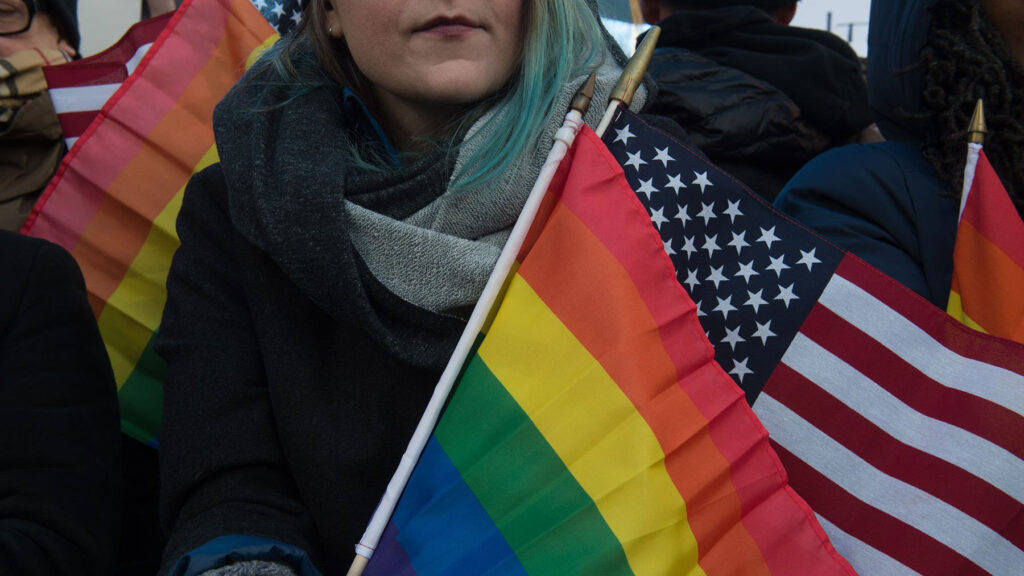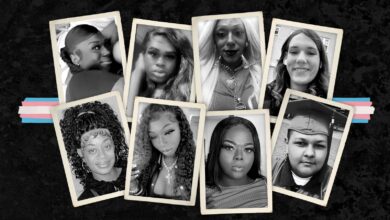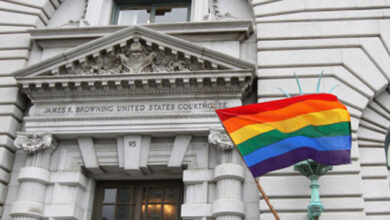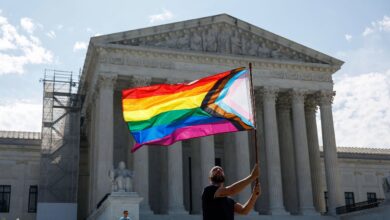Immigrating While Queer: America’s Complex History of Exclusion
The journey for LGBTQ immigrants has been difficult for decades.

This story was originally reported by Kate Sosin of The 19th. Meet Kate and read more of their reporting on gender, politics and policy.
In 2016, anti-LGBTQ+ extremists broke into the apartment of Bangladesh’s only LGBTQ+ magazine editor, Xulhaz Mannan, and murdered him and friend Mahbub Rabbi Tonoy. Tara Asgar was there, but she managed to escape.
She needed to get out of Bangladesh.
“I was a queer, gender-nonconforming person with no institutional protection, navigating state systems that were openly hostile toward people like me,” Asgar said. “Leaving Bangladesh became less a decision and more a fight for survival.”
It was three difficult months before Asgar got a one-year visa to the United States. She fled to Maine. The move was complicated. It likely saved her life, but she was entering a country on the brink of electing Donald Trump after a presidential campaign based on hostility to immigrants, one that was starting to debate if transgender and gender-nonconforming people should be allowed in public spaces.

“The American discourse around trans rights was fracturing along partisan lines; visibility was increasing at the same time as backlash,” said Asgar. “This country is not a uniform ‘safe haven’ for queer or trans people. It is a place where safety is uneven and always entangled with race, class, immigration status, and geography. Visibility here carries its own risks.”
Accurate historical data on LGBTQ+ immigrants is scarce. Today, it is estimated that approximately 1.3 million queer immigrants live in the United States, and that 3 percent of all immigrants identify as LGBTQ+.
But immigrating to the United States as an LGBTQ+ person has never been easy. In fact, for most of American history, officials have used sexual orientation and gender identity to exclude large swaths of migrants.
The official ban on LGBTQ+ people migrating to the United States was struck down 35 years ago this month. But LGBTQ+ people remained largely blocked for the next four years due to homophobic laws and policy, according to Karma Chávez, professor of Mexican American and Latina/o Studies at the University of Texas at Austin. Still, many LGBTQ+ people have held up the United States as a beacon of hope, regardless of anti-gay laws.
“You know, I think people find things are very different when they get here, but the idea of a certain kind of freedom that Americans supposedly enjoy looms large,” Chávez said.
Tracing exactly how long the United States has blocked LGBTQ+ migration is a little trickier, she said. That’s partly because the laws preventing queer immigration were not explicit. Moreover, immigration officials have long relied on LGBTQ+ stereotypes in determining if an applicant is queer, say experts, making it hard to determine if a person who is not allowed into the country truly identifies that way or has just been perceived as such by officials.
The 1800s
Many experts say the first attempt to block LGBTQ+ people came in 1875 with the Page Law. The Page Law barred women deemed “undesirable,” such as convicts and laborers, and specifically targeted Asian women.
“A big part of the restrictions in the Page Law was to keep out ‘sexually promiscuous’ Asian women who were likely to become public charges because they didn’t have men to take care of them, and then they were going to engage in deviant behavior to survive,” Chávez said.
Though not specifically about LGBTQ+ people, language that was sexually specific was seen as the first snag that might catch LGBTQ+ immigrants trying to enter the country.
Through the 1980s
The Immigration Act of 1917 barred “people with abnormal sexual instincts,” a convoluted way of saying gay and lesbian people. Chávez and others said this was the first law that directly targeted sexual minorities.
The government would more strongly reiterate these views in 1952 during the Cold War with the Immigration and Nationality Act, according to Aaron Morris, executive director at Immigration Equality, a nonprofit that fights for LGBTQ+ immigrants.
“Thinking about 1952 and where America was at the time, fast forward to 1965 when we’re looking at the civil rights movement, the gay liberation movement, women’s movements, there’s a lot happening in the 60s, and then the law becomes much more focused to ban people who are suffering from ‘sexual deviation,’” Morris said.
Queer people were again barred entry in 1965 by the Immigration Reform Act as “aliens afflicted with sexual deviation.” But 1972 brought relief because the American Psychiatric Association removed homosexuality from its list of mental disorders.

By 1980, the United States was finally ready to change its rules when it came to LGBTQ+ immigrants.
Two things happened that year. The first was that the Refugee Act expanded the legal definition of refugee to include people being persecuted because they were part of a protected group. This did not explicitly include queer people, although some would argue that it should. The other thing that happened was the Mariel boatlift, a mass migration of 125,000 Cuban asylum seekers to the United States.
“Many of the people that came were transsexuals, homosexuals, people who would be considered sexual deviants,” Chávez said. “In the U.S., we sort of opened the flood gates, really testing out our core Cold War values when it comes to asylum.”
The LGBTQ+ people who won asylum from the crisis got asylum based on their persecution by the Communist Party, not their sexual orientation or gender identity, Chávez said.
“But this [claim of asylum based on being LGBTQ+] begins to get tested in a bit more formal sense throughout the 80s,” said Chávez. “And there are some cases of people who do attempt it.”
The results were mixed, with some prevailing and others failing.
Lifting the ban
The Immigration Act of 1990, signed into law by President George H. W. Bush, would mark the most significant stride for LGBTQ+ immigrants yet. The law officially repealed the ban on queer migrants. But it fell short of allowing most queer people to seek safety within the United States, noted Jenny Pizer, senior attorney at Lambda Legal.
That’s because the law required that family sponsors be related by blood or marriage, something many queer families didn’t have.
“Allowing a lot more people to come as immigrants was not helpful to members of our community with a relation where the family relationship required marriage,” said Pizer.
The cases that made the law
That same year, the Board of Immigration Appeal awarded humanitarian protection to a man by the name of Fidel Armando Toboso-Alfonso, who faced abuse in his native Cuba for being gay.
Four years later, in 1994, Attorney General Janet Reno issued an order stating that his case set a precedent. From that moment on, the order said, a person who had been persecuted by their government for being homosexual may be eligible for asylum in the United States. That opened the door for LGBTQ+ people to immigrate to the United States and seek asylum.
Three years later, another watershed moment came in the case of Pitcherskaia v. INS. Alla Konstantinova Pitcherskaia sought asylum relief in the United States after Russian authorities tried to “cure” her of being a lesbian using electric shock therapies. Though the Board of Immigration Appeals agreed that the shock treatments were meant to “cure” her, the U.S. Court of Appeals for the 9th Circuit reversed that decision and Pitcherskaia prevailed in her claim.

Another precedent-setting case came in 2000 when Geovanni Hernandez-Montiel, a 21-year-old gay man from Mexico, won his asylum claim in the United States, bolstering similar claims by other LGBTQ+ immigrants. Still, it would be another 15 years before the Supreme Court affirmed marriage equality in 2015, allowing queer spouses to sponsor each other for immigration purposes.
For transgender immigrants, the journey to legal entry in the United States was more complicated.
As Morris put it, “the Board of Immigration Appeals, which was doing more marriage-based stuff, was having a hard time deciding when someone was in a same-sex marriage or was in a different gender marriage,” Morris said.
The board’s first solution was to effectively ban transgender people from claiming asylum in the United States, Morris said. Asylum lawyers countered, saying the ban was discriminatory and overly broad. The board struck down the ban in 2004, although a policy allowing trans people to legally enter the country didn’t take effect until 2007.
It took, however, four more years for the United States to remove its mandate that trans migrants get gender-affirming surgery before migrating in their lived gender or sponsor opposite-gender spouses.
The reality now
Today, LGBTQ+ people enjoy marriage equality and other federal benefits, but some worry that those laws face challenges in the courts, imperiling queer immigration rights.
In a recent opinion piece in Time, Fernando Chang-Muy, a professor at Pennsylvania Carey Law School , and high school senior Sebastian Irausquin-Petit argued that the country has abdicated its responsibility to queer asylum seekers by pursuing homophobic and transphobic policies under the Trump administration.
The authors point out that Trump ordered transgender and nonbinary identities erased from federal documents.
“Because the asylum process demands consistency across forms, nonbinary refugees now face an impossible choice: misrepresent themselves on paper or risk rejection for ‘inconsistency,’” they wrote.
Asgar still lives in that reality. Nearly 10 years after immigrating, she is still waiting for an asylum interview.
“Outside the U.S., there is a persistent belief that being queer or trans can act as a kind of exceptional category, that transness itself fast-tracks one’s journey to citizenship,” she said.
But being an immigrant has been like a second closet for her, one where she must prove over and over again that her story is tragic enough to earn her entry into the United States.
“As a trans migrant, my body is already a site of border-crossing: between genders, between cultures, between systems of recognition and misrecognition,” she said. “For me, the experience of being a trans migrant is shaped by this tension, between the freedoms I chase and the limits I confront, between the borders that confine me and the borderless kinship I come from.”










